#Signifiers of Britishness
Explore tagged Tumblr posts
Text
Socmed discussions about Saltburn, to me —
1) reveal that people are even more squeamish about explicit gay sexuality than they think they are
(And if this is what passes for shocking erotic excess, then we, in the anglosphere, are in a more — not making a comment about individuals here — restrained moment with mainstream American/British adult cinema than we were with mainstream adult heterosexual cinema in the 90s, eg the erotic thriller)
And
2) suggest people are increasingly making art that is in conversation with, if not explicitly nostalgic for, the 2010-16 Tumblr-era.
(I really truly suspect Saltburn is, in part, an adaptation of the tropes and aesthetics that were in certain “The Social Network” fan spaces.)
#Saltburn is a period piece of this very specific very Anglophile tumblr moment#that specifically was obsessed with poshness and the upper class (usually more or less aristocratic) of the UK#much of the tumblr cultural backlash to that moment (eg the British accent jokes now; the food jokes)#is just USAmericans getting embarrassed over having prostrated themselves at the uncaring altar of British old money#and in response to that embarrassment these USAmericans I guess just started shitting on poor British class signifiers (eg usually a lot of#the mockery is about northerners esp northern women)#which is really just a continuation of tasteless American passes at being ‘above’ the poor brits they’re mocking to align with the landed#and titled of the UK#which lol they hate you just like they hate the poor British!! silly silly silly attempt to appear worldly#and to be clear my comments are about a specific kind of American-Brit beef between white tumblr users#and none of the conversation is meaningfully about British colonialism or American cultural or literal imperialism#or even about anglocenticism in general#j realize this a lot to write about something that can be boiled down to : specious and inane comments r being made by the stupidest of the#site from the imperial core of the world#and it’s usually between users who have no fucking business making class jokes#because critically the experiences they’re mocking are so removed from any struggle for survival they’ve had — on both the USA and UK side
14 notes
·
View notes
Text




also just missing beard’s polos, too. his s1 fashion will always be mourned BY ME
#i don��t give a damn about them making his clothing ‘more British’ to signify his preference of Britain and settling in#I miss his hoodies and polo shirts#remade the grey one in animal crossing lmao
2 notes
·
View notes
Text
God, I remember that rainbow jigsaw puzzle bomber jacket. It was, well, fabulous.

#I read an interview with Jennifer Saunders saying#that it got harder and harder to write AbFab#because of the changes in conspicuous consumption and luxury over the past few decades#the recognised signifiers of wealth and excess#she said 'when we started‚ drinking bottled water was extravagant'#makes one think#with that said: eddie monsoon definitely owned a juicero#absolutely fabulous#jennifer saunders#joanna lumley#90's#television#sitcom#vintage#british#early 90's#1992
43 notes
·
View notes
Text
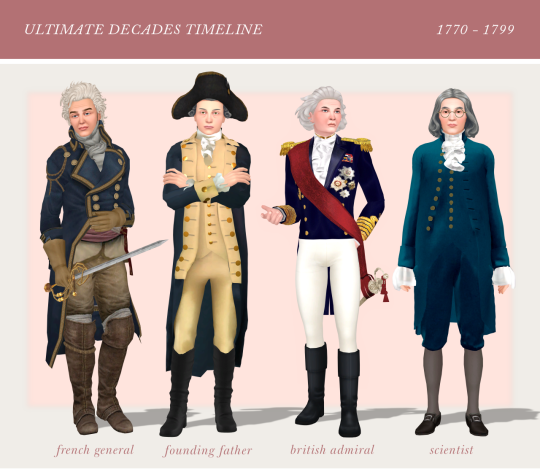
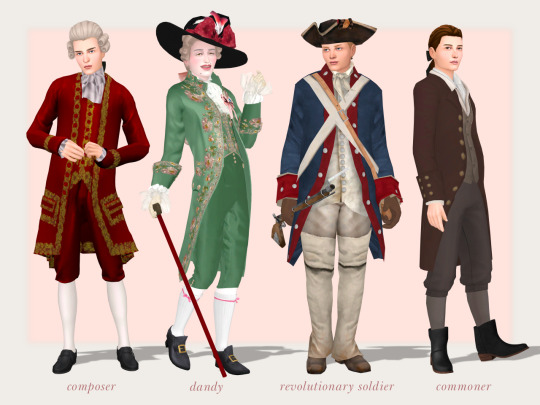
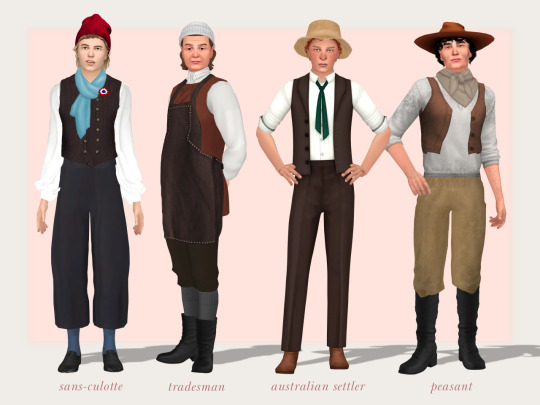
The wide silhouette of the early century started to slim come the mid century, and it slimmed even more so come the 1770s. Style in general was becoming more simplified, leading to fashion that exemplified the new 'casual' aesthetic. The habit à la française came into mode for men, showcasing the standing collar that would carry over into the early 1800s. The front skirt of the coat started being cut back, exposing the front of the breeches. This resulted in waistcoats becoming shorter and breeches becoming tighter to exaggerate the new silhouette. In direct contrast to this move toward simplicity, dandies outfitted themselves in eye-catching and visually lavish ensembles. Their style loudly announced their cosmopolitan, fashion-centric outlook, and their sartorial choices blurred the line between masculine and feminine.
We've now finally hit the point in the historical timeline where I can represent my home country! While the early white settlement of Australia is typically associated with the convicts that were shipped to penal colonies in the newly discovered country, by the late 1700s free settlers were also making it home. Many of these settlers built homesteads and farmed the land for survival. It was a tough life and their practical clothing reflected as such.
The end of the 18th century saw a great deal of political unrest, most notably in France. The French Revolution had a huge impact on clothing as it became increasingly important to outwardly show your republican support via your stylistic choices. Waistcoats were still very much a part of a man's everyday wardrobe, and often times they were decorated to show political sympathies. The 1790s saw the rise of the sans-culottes - working class men who shunned the wearing of breeches in favour of loose trousers. These were often paired with a red wool cap known as a bonnet phrygian, which signified the wearer's hardcore dedication to the revolution. CC links under the cut.
You can find more of my historical content here:
1300s ✺ 1400s ✺ 1500s ✺ 1600s ✺ 1700s ✺ 1800s

FRENCH GENERAL
Hair | Sideburns (TSR) | Outfit | Sword
FOUNDING FATHER
Hat | Hair | Suit | Boots (TSR)
BRITISH ADMIRAL
Hair | Hair Colour | Top (TSR) | Baldric & Sword | Pants (Base Game - Leggings) | Boots
SCIENTIST
Hair | Glasses | Suit | Hose | Shoes
COMPOSER
Hair | Hair Colour | Suit | Hose (retired - direct download) | Shoes (Vintage Glamour)
DANDY
Hat | Hair & Hair Bow | Suit | Brooch | Gloves | Cane | Hose (TSR) | Socks | Shoes (TSR)
REVOLUTIONARY SOLDIER
Hat | Hair | Outfit | Rifle
COMMONER
Hair | Suit | Hose | Boots (TSR)
SANS-CULOTTE
Hat (TSR) | Hair (TSR) | Scarf | Top | Rosette | Pants | Hose | Shoes (Modern Menswear)
TRADESMAN
Hat | Hair | Outfit | Apron | Socks (Base Game) | Boots (TSR)
AUSTRALIAN SETTLER
Hat (TSR) | Hair | Outfit | Hand Dirt (Werewolves) | Boots (Base Game)
PEASANT
Hat | Hair (TSR) | Face Dirt (Get Famous) | Scarf | Top | Waistcoat (TSR) | Pants | Boots (TSR) | Dirt
With thanks to some amazing creators: @joshseoh @eggysimblr @the-melancholy-maiden @revolution-sims @joliebean @imvikai @stereo-91 @waxesnostalgic @peebsplays @historicalsimslife @mmatteog @makesims @faded-springs @nell-le @dogsill @sloedancing @hexcodesims @simverses
#ultimate decades challenge#1700s#rococo#georgian#ts4 historical#sims 4 historical#ts4 decades challenge#sims 4 decades challenge#the sims 4#ts4 cc cas#lookbook#18th century#ts4 lookbook#sims 4 lookbook#s4 lookbook#ts4 history challenge#historical lookbook#rococo fashion#georgian fashion
242 notes
·
View notes
Text

Book of the Dead of Henuttawy (Lady of the House; Chantress of Amun)
Within this papyrus, we see a rather unique depiction of Osiris, depicted here as the night sky and referred to as “Osiris Foremost of the Westerners, maker of heaven, maker of earth, maker of the netherworld”. Osiris is seemingly resurrected, his manhood noticeably restored.
Geb, god of the earth, appears below, and appears to be performing autofellatio, which possibly signifies “self-sustaining fertility”.
Beside this image of Osiris, is the goddess Nut in a similar pose, a pose she is actually more recognizable for as the goddess of the night sky; on fingers and toes she hovers above the earth god Geb, who is now seen with the head of a snake.
Third Intermediate Period, c. 1070-664 B.C. British Museum. EA10018,2
159 notes
·
View notes
Text
a PSA for anyone who is confused by the panic over the UK heatwaves! ☀️
the UK has an amber warning declared for a heatwave this weekend, where temperatures will reach above 30C (86F). to many, especially Americans, this doesn't seem like a notable temperature, and i've seen many ignorant posts mocking UK residents who are worried about how they and their loved ones will be affected by the temperatures. i'd like to explain why heatwaves in the UK are different than other parts of the world, and why they cause such a panic: 🔥 because we are an island nation, our heat isn't dry: it's horrendously humid. high humidity means that your lungs need to work harder to breathe, and it's much harder for your sweat to evaporate in the air. sweating is how your body regulates its temperature, and you sweat more in humid environments. when sweat doesn't evaporate it remains on the skin, leaving you feeling hot, sticky, and ill. 🔥 our homes and buildings are built to retain heat. because the UK is so cold and rainy for the vast majority of the year, our homes are supposed to trap heat, not let it out. not only are our homes smaller on average, but between double glazing, cavity wall insulation and loft insulation, when heat hits a British home, it causes a greenhouse effect. heat just sits in our homes, and it doesn't dissipate at night, meaning we are unable to sleep. 🔥 we have no air conditioning. i have never been in a home with air-con, and very few public buildings have it (except some shops). because of the aforementioned cold, rainy conditions that affect the UK for the vast majority of the year, air-con has never received a significant roll-out here. this means that we have little to no relief from being inside buildings besides being in the shade, and few homes even have fans. 🔥 our city centres are packed and highly urbanised, which causes heat traps. because our streets and homes are often stacked tightly together, including rows of houses/buildings/etc., heat in densely packed areas has nowhere to go, and will simply sit. trying to walk through a city during a heatwave will leave you sweating and exhausted in minutes. likewise, there are limited spaces to go to cool off during these temperatures: people will literally go to the shops to stand in the fridge/freezer aisles. 🔥 our infrastructure is not built to cope with heat. during heatwaves, our tarmac melts. the rails which hold our trains bend and warp. our grass catches fire. a few years ago, airport runways cracked and lifted in the heat, halting flights. the UK is brought to a standstill during high temperatures because our cities and towns are built for colder, wetter temperatures. add in the 16 hours of daylight we get during the summer, and you have a recipe for disaster. 🔥 the hottest temperature ever recorded in the UK is 40C (104F). this was in England, and in other UK countries, it's even lower: in Wales, it was 37.1C (98.78F); in Scotland, it was 34.8C (94.64F), and in Northern Ireland, it was 31.3C (88.3F). because these are our highest temperatures, many of us are unused to the symptoms which signify heat exhaustion or heat stroke. i need to emphasise: people die during heatwaves. i highly encourage people to read about the 2022 UK heatwaves, which saw the deaths of nearly 3000 people (many of whom were elderly). we could do nothing but hunker down and survive the heat during this time, and it was especially dreadful for anyone who is older, disabled, and/or neurodivergent. so while 30C is not unheard of in the UK, any heatwave poses significant risks, including illness, disruption to transport, wildfires, and even death. thanks for reading, and to everyone from outside the UK who's provided useful advice on keeping cool! i'm sure we'll be alright, but i'm hoping folks won't parrot misinformation about us just 'not being able to cope with the heat' 💔
#the 2022 heatwaves were insane. i don't think i moved for days#unfortunately this 'lmao look at these idiots who can't cope with heat' sentiment is one i've often seen expressed by Americans#who take their air-con and large airy homes and dry heat for granted and assume the rest of the world functions exactly like America#i remember being trapped inside and seeing that mockery on social media in 2022 while reports came in of all the deaths. it was dreadful#so yeah be kind to anyone you know living in the UK right now we're going to have a fun weekend 🙃#(signed an autistic migraine-haver whose temperature regulation is god awful at the best of times)#heatwaves#british heatwaves#british heatwaves 2022#climate#climate change#uk#starleskatalks#long post#tw: death#tw: illness
95 notes
·
View notes
Text
There’s a move that RTD has been doing recently that I don’t really have a Judgement on, like I can’t say if it’s Good or Bad, but it is FASCINATING to my specific dr who preoccupations
He is (selectively, only sometimes) bringing racism that has always been present in dr who into the diegesis. I first noticed it with the Toymaker; instead of being a racial caricature in the same way his ‘65 appearance was, the 2023 toymaker is a character who poorly appropriates the signifiers of real-world cultures as part of his style of Play. He’s not just an East Asian caricature non-diegetically played by a white man. He is, within the diegesis, a white man who intentionally disrespects earth cultures by imitating and parodying them. We only see him directly do this to white/western cultures (the German, French, American, and British accents he takes), but he’s clearly textually racist to characters of color in the episode.

Racism and racial stereotype are some of the Games the toymaker plays. They’re not erasing racist production/narrative decisions. They’re placing them in a new context.
“Dot and Bubble” is the same; it recontextualizes previous adventures with all-white casts, not by reimagining them as more diverse, but by making that lack of diversity diegetic. I’ve seen some point out that previous episodes had, unexamined in the narrative, few characters of color either as a critique of “Dot and Bubble”. How can RTD expect us to notice that the cast is all-white as something with narrative significance when we’ve seen the exact same not ten years ago portrayed as a completely normal state of affairs? But I think part of the specific narrative moves that this episode is doing is that we can also examine those past episodes through this same new context. That the white Doctor, and his white companions, were not forced to encounter the circumstances that made the situation they’re in all-white, and so they did not at all engage with them. This is not to say that these previous episodes were intentionally saying anything at all about racism; they were the product of racist writing and casting, and that can’t be changed or ignored. But fan analysis as a school of thought is often far more concerned with the watsonian than the doylist, and RTD is aware of this as someone who grew up in fandom. This provides a watsonian path to exploring the racism of the show’s history, without sugarcoating or ignoring it.
It’s worth noting when he doesn’t do this as well; he seems far more willing to engage diegetically with racism than ableism, for example. Davros does not get any sort of redemption or examination as one of the only wheelchair users we see in the vastness of time and space; instead, he is simply no longer a wheelchair user. I think we should be paying a lot more attention to what gets folded in narratively and what doesn’t because it seems very clear that RTD is intent on continuing doing this and it’s something I’m keeping my eye on. Again, I don’t know whether it’s Good or Bad that this is happening, but it sure as fuck is interesting
#I did shit this out in like one 30-minute ramble so it might be incoherent#dw spoilers#doctor who#the show of theseus#dot and bubble#dw criticism#the giggle#not described
476 notes
·
View notes
Text
Hogwarts Fashion During Hogwarts Legacy
A cheat-sheet for making your writing/art historically accurate, and some inspiration for your MC - women's addition.

Victorian fashion was complicated, both in terms of the construction and the rules that dictated when certain garments could be worn. Age played an important role in what a person was permitted to wear, so lets break it down that way:
Younger Students (Roughly years 1-4)
Generally speaking, girls dressed in similar styles to their mothers, but with altered hemline lengths. Up until roughly 13-14 years old (exact ages were decided by the girl's family) her hemline would fall around the knee. At 14 it would be lowered to the middle of the shins.
At this age girls would wear dresses, and so you could suggest that Hogwarts uniforms for girls at this age would not consist of the shirt and skirt combo that MC and various NPCs wear.
Most schools in the 1890s did not have set uniforms, but instead girls were expected to wear an apron to protect their clothes from ink and chalk dust.
At this age it was still considered socially acceptable for girls to wear their hair down, or in more simple hairstyles like braids. Popular hair accessories included ribbons and straw hats.
Time for some examples:
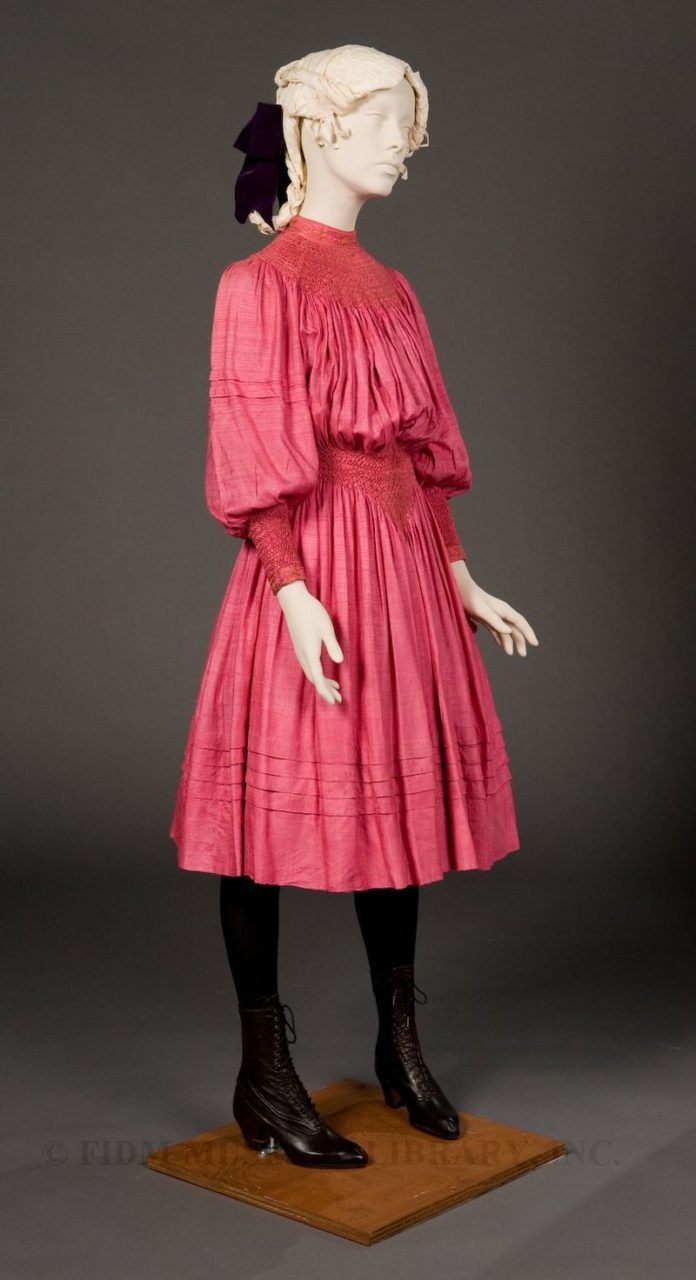
This is an example of a day dress (casual clothes) from 1893. Smocking (the embroidery technique used at the collar, waist and cuffs) was popular in young girls clothes.
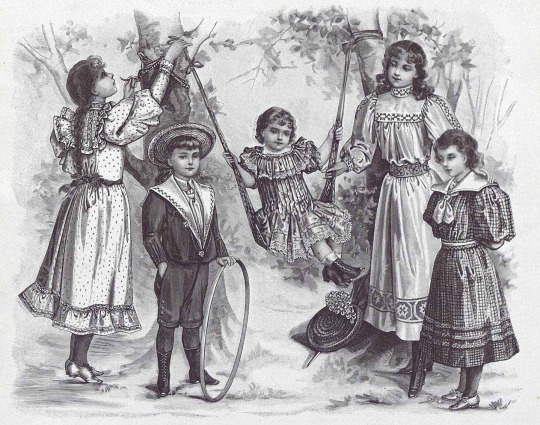
Another example of children in day dress. The girl on the far left is probably about 13-14, the older girl on the right is closer to 15.
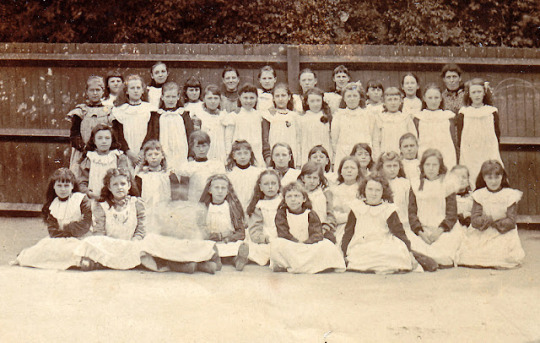
An example of the aprons worn by younger students.
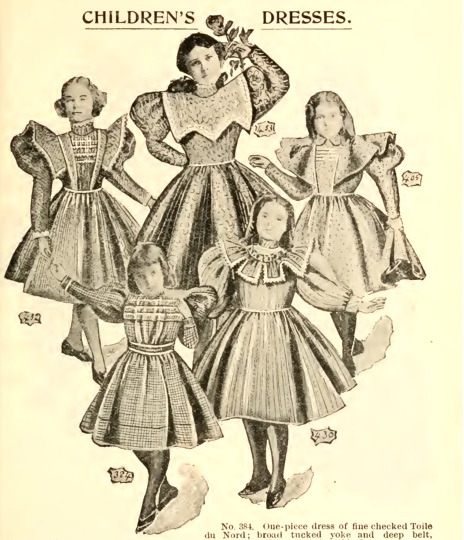
Details of the dresses worn underneath (technically from 1897 but the styles are fairly similar)
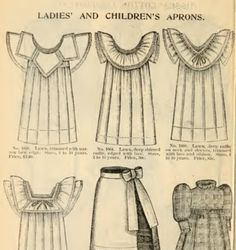
Details of the aprons worn
Older Students (Roughly years 5-7)
Around the time that the MC joins at Hogwarts, she would, depending on her personal preferences, have kept her skirt at her mid shin or dropped the hem to her ankles. Around the age of 17, girls would be expected to fully let down their hems to the floor, signifying their shift to adulthood.
At this point dresses would become less popular during the day, and were replaced by blouses (complete with very large sleeves) and a skirt. Men's tailoring and sports clothes shaped women's fashion at the time, and greatly influenced what girls wore at this age.
Girls would also typically stop wearing their hair down during the day, resorting to simple up-dos instead.
The time at which each girl made these changes depended on her and her family. While some girls had no choice but to listen to their parents, often they were able to bargain for an extra few months if they so wished.
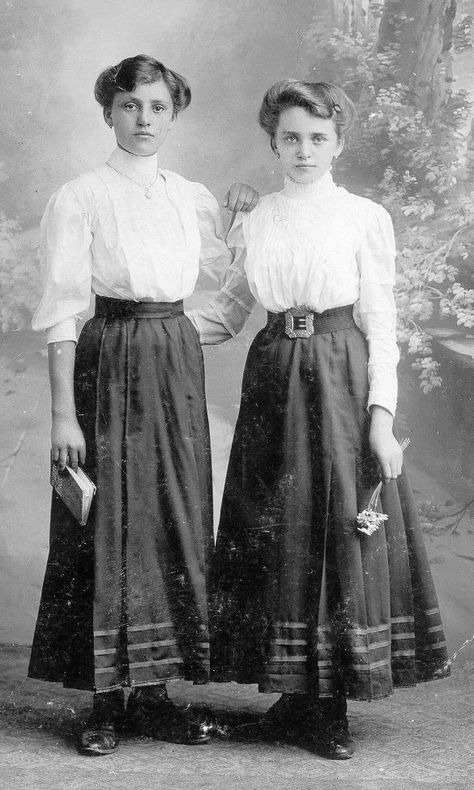
An example of two girls around the age of 15 in very typical day outfits.
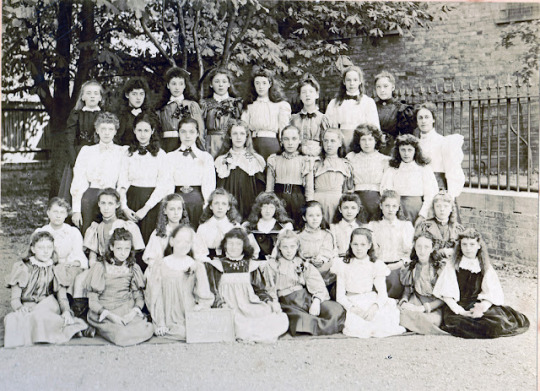
A selection of school girls - those sitting are no older than 14, those standing are no older than 16.
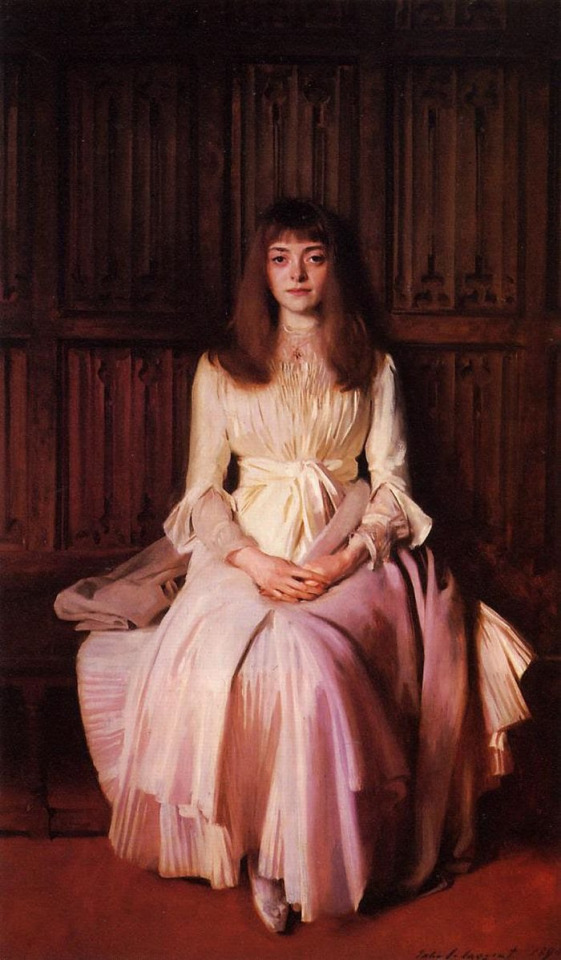

At the age of 15-16 girls would begin to attend more family functions and required new styles of clothes. These paintings show the same tea gown. These were made to be worn at home, never in public, when the family was hosted guests or a less formal dinner. They could be worn at all times of the day.
Day clothes for students who dressed as adults (17+):

A British Upper VI class (age 17-18) and some teachers in 1894. All girls now wear dresses with their hems on the ground, and hair tied up.
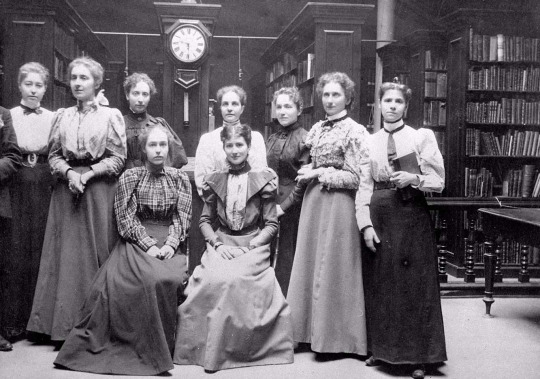
Middle class girls fashion in the 1890s
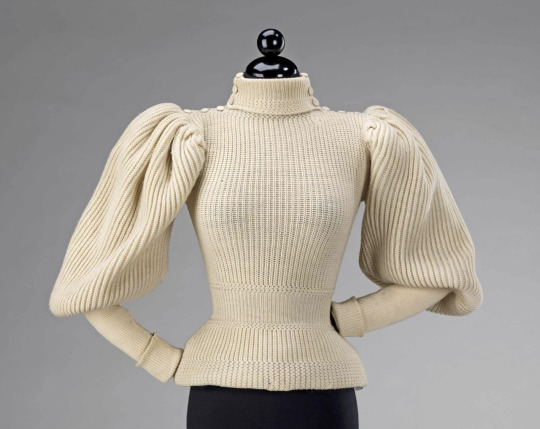
A Woman's sweater from 1895
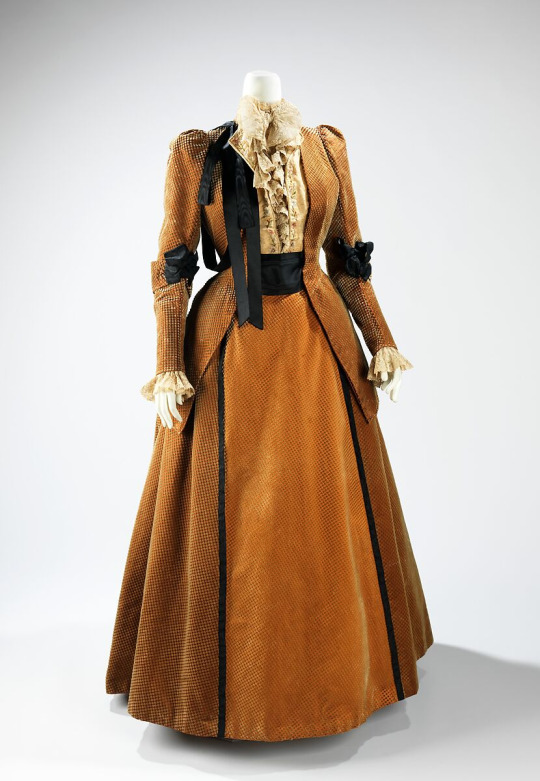
Walking outfit from 1894 - essentially a more substantial outfit for spending time outdoors.
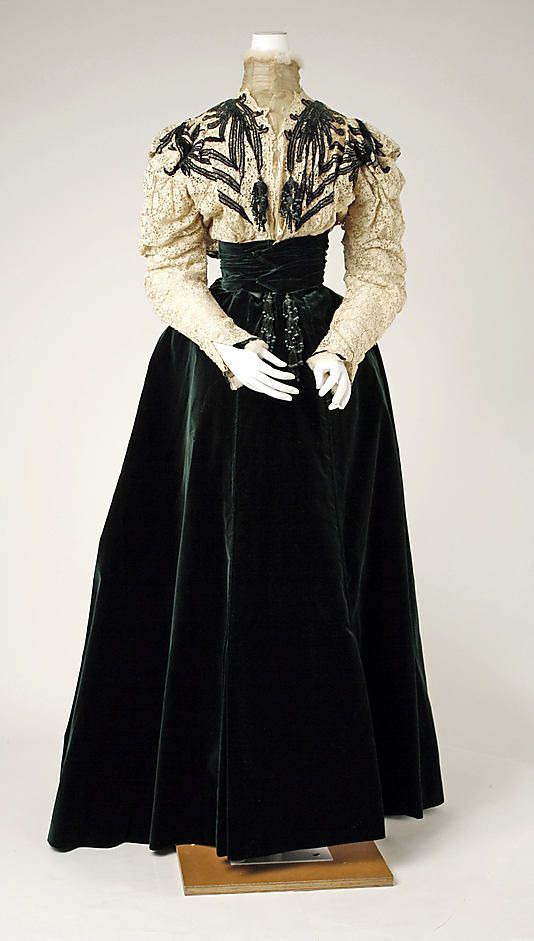
A more expensive version of a day outfit.
Tea gowns:
Generally identified by their loose fit, high neckline, and a train that falls from the shoulders. Additionally they may also be made with a large coat over the top. The shape was inspired by medieval fashion and so they're a good source of inspiration for the wizarding world imo.
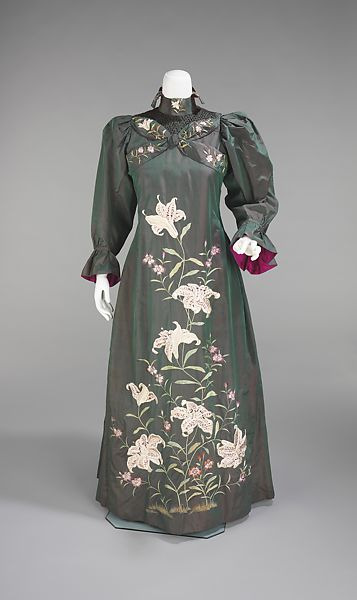
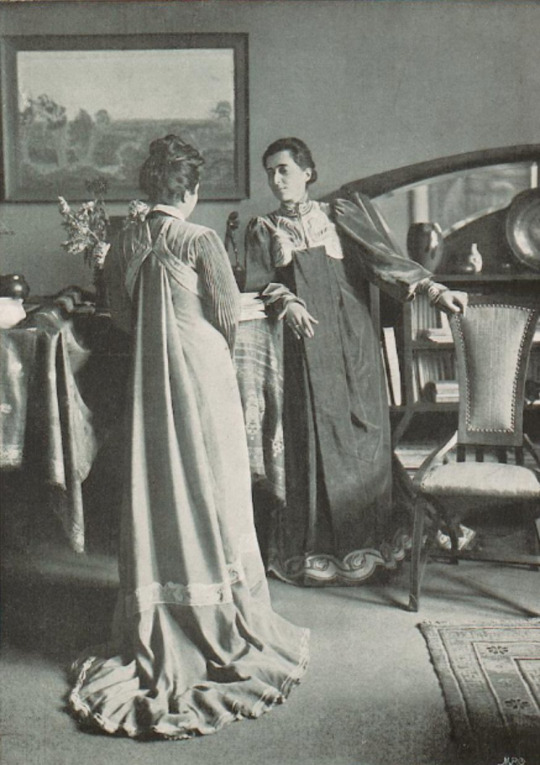
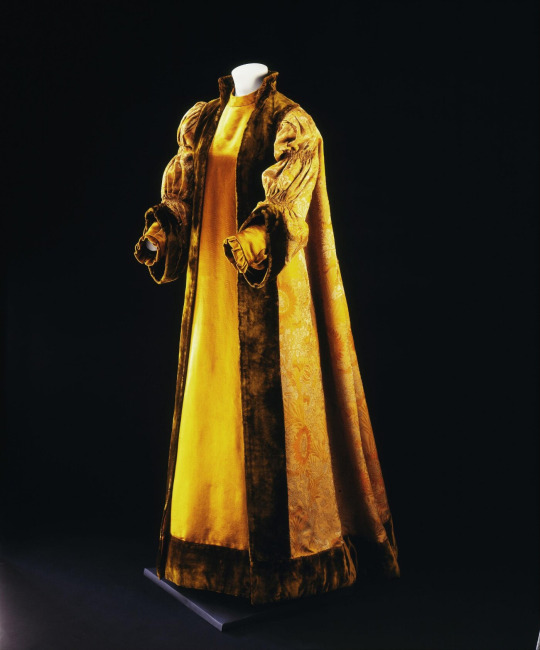

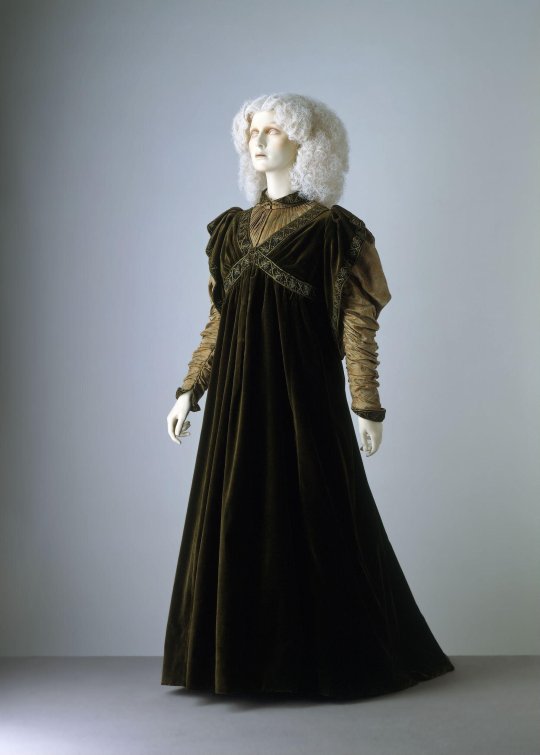
Evening gowns:
Worn for the most formal evening events, and generally expose more skin than day clothes. Staple accessories included fans, opera gloves, and (if you're that way inclined) tiaras were coming into popularity at this time.
Rule of thumb for all fashion at this time, the sleeves get largest in the middle of the decade, and shrink back down again towards the end.

1894
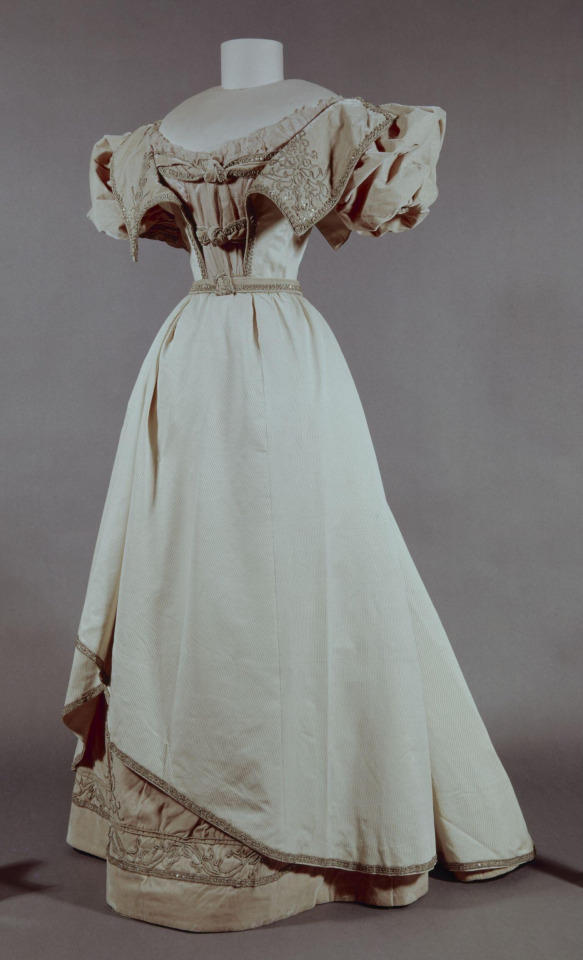
1893
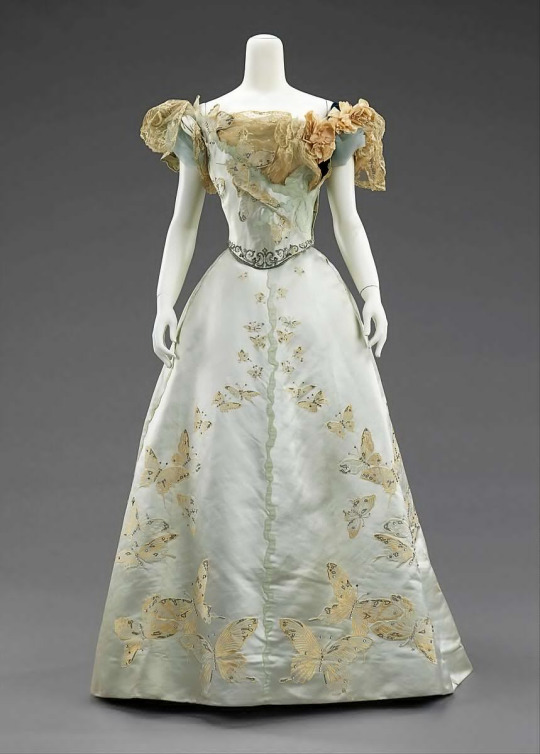
1898

1893-1895
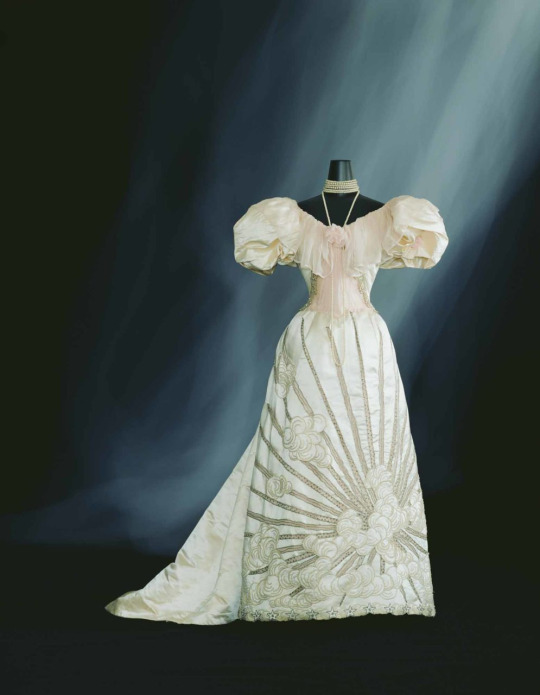
1894

1898
#Wow first post on this account is the nerdiest thing i could possibly pick#enjoy!#hogwarts legacy#harry potter hogwarts game#sebastian sallow#sebastian sallow x mc#sebastian sallow x you#sebastian sallow x reader#ominis gaunt#ominis gaunt x you#ominis gaunt x reader#garreth weasley#garreth weasley x mc#garreth weasley x reader#ominis gaunt x mc#hogwarts legacy art#hogwarts legacy mc#historical references#fashion references#1890s
2K notes
·
View notes
Text
a few fun facts about pureblood wizarding families (while i try to finish the next chapter of valkyrie)
the lore for these aren't fully fleshed out yet but whatever let's just have fun, shall we?
firstly, the sacred twenty-eight aren't the only pureblood wizarding families. cantankereus nott was just a bitch and left many families off because they didn't meet his "standards" of how they conducted affairs in pureblood circles and the notts often profited off the turmoil within other powerful households.
the notts have long held a grudge against the potters going back centuries
the averys and the potters practiced blood magic and necromancy during the renaissance, and held ancient texts which were heavily guarded and kept secret even up until present day (including secrets of the dark arts, useful in the creation of horcruxes). the averys were proud of this history, the potters were not
the prince family are descendants of arielle slytherin (salazar slytherin's youngest child and only daughter) and merlin (of the round table). merlin's myth was deliberately narrated as centuries older than he actually was to preserve the secrecy of the wizarding world. prince comes from merlin's title, "the prince of enchanters", with his and arielle's only child being named arthur for merlin's friend, king arthur
as a result the prince family holds in high esteem their connection with "wizarding royalty"
the lupins emerged out of a british colony in north america, hunting wolves and using their pelts for wizarding robes. eventually they returned to britain but due to a lack of wolf packs in the area, they pivoted to other materials (like snakeskin). eventually, the once-wealthy family fell into poverty and became farmers in wales. the lupins continue to hold a hatred for werewolves, blaming them for the downfall of the lupin family
there's still a north american branch of the lupins, known now as the lovetts (which means young wolf)
the gaunts invented the cruciatus curse, as well as other spells in the dark arts
the blacks partially orchestrated the downfall of the gaunts in pureblood society, seizing on the gaunts dysfunction (as a result of abuse and inbreeding across generations) to position themselves as the new royalty of the wizarding world
the lestrange family was divided once a branch moved to the uk, as both sides believed that either france or britain was the future centre of the wizarding world and despised the other
at the age of ten, lestrange children are led in a ritual to slaughter an animal and burn its bones in a bonfire surrounded by family, as to signify their coming of age in the magical world without reservations or fears
the malfoys have long been associated with veela, leading to their pale and softer features down the line
the malfoys were philanthropists, and considered less extreme on blood status (willing to marry half-bloods, associated with the british monarchy and using those connections to profit behind closed doors. were very involved in high class muggle society until 1692 with the passing of the statute of secrecy, which they initially opposed but later switched and cut ties publicly with muggles)
the mulciber family originated in zimbabwe and were notably proficient in the expelliarmus and imperius curses
the weasleys and the malfoys are inextricably linked, having come to britain around the same time (the invasion of william the conqueror) and have long been enemies, particularly in politics
every eligible heir (ie not disowned, pureblood, mentally "sound") in the black family is arranged to be married, with plans beginning in childhood or even infancy but generally being more or less set by the child's entry into hogwarts. the marriage occured directly after graduation, and was used to strengthen ties with other pureblood families
however, flaws in this system led to inbreeding (organized marriages between cousins), large age gaps (up to ten years), forced rape/pregnancies (even when the parents were still at hogwarts), and female babies being deprioritized in the pursuit of the continuation of the black name. despite this, infertility runs in the family and many children die young (leading to the desire for big families)
at thirteen, the black children are honoured in an initiation ceremony, where they receive a knife carved with the black family insignia. children as young as six begin training with knives to allow them to fight even if magic cannot be used, and all black family members carry their knives with them up until their deaths
there is a class system in pureblood politics. families such as the blacks, the malfoys, the gaunts, the rosiers, and the lestranges are considered "wizarding royalty" and hold the most sway in society and politics, due in part to a) historical connections, b) wide-ranging bloodlines, c) considerable wealth, or d) magical prowess. other families, such as the mulcibers, the pettigrews, the vanitys, and the weasleys were considered flip votes and could often be manipulated easily. typically, the allies in pureblood politics against the wizarding elite are the potters, the longbottoms, the moodys, the abbotts, and the fawleys
let me know if this was fun! i'll definitely do more as i flesh out different families (there are a bunch on the sacred twenty-eight that i have yet to explore) so stay tuned! also, let me know your headcanons for the families!! :)
#marauders#marauders era#valkyrie#the noble and most ancient house of black#ominis gaunt#narcissa malfoy#lucius malfoy#billius weasley#arthur weasley#molly weasley#james potter#evan rosier#pandora rosier#felix rosier#xenophilius malfoy#neil avery jr#milton mulciber#remus lupin#lyall lupin#severus snape#eileen prince#bellatrix lestrange#rodolphus lestrange#rabastian lestrange#sirius black#regulus black#narcissa black#andromeda black#bellatrix black
98 notes
·
View notes
Text
The Boundaries Of Love (In Worldbuilding)
Hey, does love exist?
This is one of those frustrating kinds of philosophical questions because there’s a host of stuff in the real world that exists, fictionally, but that doesn’t mean the material of it actually exists. In the real world, countries definitely exist, but there’s nothing about the country existing that’s true outside of the people in the space enforcing that identity. Numbers and math exist, in that you and I can both execute on their systems and get the same results suggesting some kind of central uniformity, but there’s nowhere you can go to get a cup of four.
In the real world, love is not an object unless you want to get into truly ontological spaces of what an ‘object’ is. It isn’t stuff, it isn’t material, it’s a fiction, in that it is also a term that is used to reference a signifier that humans can relate to based on its meaning. And those meanings are… weird. Those meanings are manifold and complicated, and this is, I must make clear, not a thing that’s true of all cultures everywhere.
Love is very ambiguous in English, because it’s a word that’s meant to cover a host of topics from the social to the theological to the preference to the experiential, and in no situation in English is love the wrong word or overstating anything but contrasting those uses with one another creates some strange discrepancies. In a vow, love is the term we use to describe a lifelong commitment’s motivation and then in the dinner after that wedding it’s a term used to describe how we feel about the nice fingerling potatoes.
I bring up English because it’s very important to remember this is localised to English. Not that other cultures are clearer in how they communicate about love, but about how that other cultures just aren’t doing the exact same thing because it’s always valuable to remember the boundaries and parameters of what your constraints are. You can use this as an angle to address, by thinking about these big, broad concepts and then trying to consider ways the concepts might be approached in different ways.
The United States and England, two major media producing cultures that share a language and use ‘love’ in similar ways still express that idea in a lot of different ways. As an example – god help us all – Love, Actually is a movie that is ostensibly about depicting love in a host of ways, and those ways include some incredibly British things that then, non-British people are able to interpret and map onto their own experiences. A Christmas novelty Single isn’t really a thing in most countries, but it didn’t stop Love Actually from selling perfectly well in America. This is because Love in this case is not a universal, uniform thing, but is a collection of floating, related signifiers. You don’t find love as a thing that exists and testing a goopy liquid in a tube, but instead, love is a thing you find by people talking about it.
This is where you can wind up with some interesting tripping points in your world. Because it’s not uncommon in worldbuilding, fantasy especially, to try and turn ‘love’ into something like a material force, or a fundamental underpinning of a magic system or something that drives psychics, and that creates a new problem. Because love is powerful. I mean, love doesn’t even ‘exist’ in our society and we still treat it as if it’s fantastically powerful, because people will do things in the name of love. Love is one of many motivators for people but it’s a really, really strong one, it’s so strong it overrides our common sense and can even lead to displays of strength or resolve that transcend all forms of survival instinct. We are really good at loving and loving is really good at being a motivator, and if that’s the case…
Like…
We already have in our real world, systems that try to weaponise love. Patriotism, for example, tries to engender a love of your country, one of those other fictions, and we do a lot to try and instill patriotism like a kind of psychic virus. That’s the real world where you can’t turn love into fluid goop and transport it, for example. When you start involving psychic powers or magical energies that can recognise and respond to the Power of Love, when there are government-impacting artifacts that care about Love, you run the risk of making it so that these are things that governments start to render programs to react to.
And that’s not necessarily a bad thing!
After all, imagine if there was a magical power of love sword in your country. Imagine if there was something that, like, cared about a wielder who was pure of heart and knew true love, and this was capable of turning the tide of armies in battles. In that environment, a government program to ensure that people could be pure of heart and could know true love would be worth doing. This is assuming there’s no ‘line of descent’ malarkey there though because then the government program to promote the use of this weapon is uh, eugenics, but if it’s just anyone pure of heart and smoochy of lips could use this weapon? Then you might wind up in a country where there’s a whole bunch of infrastructure that seems kinda weird and fanciful to people at first, where there’s a deliberate attempt to make sure people can communicate openly and honestly about love and relationships, and maybe even a more refined language for doing so, to make damn sure that people who have ‘true love’ know really well what that means and how they can use it, for when the government needs to access it.
When you look at a world, as a world builder, there’s always a chance you give away that whether or not the world is meant to have one language, it was definitely thought about in one language only.
Check it out on PRESS.exe to see it with images and links!
93 notes
·
View notes
Text
Writing Ideas: Castles
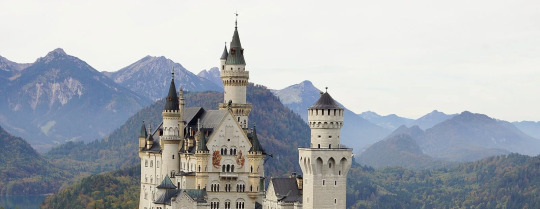
part 2
Some Castle Tropes
Big Fancy Castle: Big, elaborate, and visually impressive castles.
Bright Castle: Bright castle that signifies a good place, usually.
Good Castles, Evil Castles: Character Alignment as displayed on castle designs.
Haunted Castle: A derelict castle home to the dead or undead.
Ice Palace: A castle sculpted from ice.
Monster in the Moat: Castles with water monsters living in their moats.
Ominous Floating Castle: A visually imposing, intimidating castle floating in the sky, outer space, or an otherworldly void.
Palatial Sandcastle: A sandcastle you can live in.
Storming the Castle: A climatic assault on a fortified base.
Castles & similar structures in other parts of the world
Central and parts of Eastern Europe. Here castles weren't much different from the Western European ones. The only difference is that the local castle-building tradition was not so old; there are no Early Medieval castles in Eastern Europe, and the oldest were built during the High Middle Ages.
Russia. This country's tradition of fortification is a bit different; the rural castle never caught on here. Urban castles and citadels, called kremlins, on the other hand, were quite widespread. Kremlin is not the name of one specific famous citadel, it's a generic term for a city castle. This country also has some Romantic revival castles; these are likely to be found in rural areas.
Japan. Japanese castles, named shiro, are remarkably different in architecture from European ones, because they were built to protect the local feudal lords from local siege tactics, which differed significantly from classic medieval European sieges. Most notably, firearms found a very slow and lukewarm welcome in feudal Japan's Samurai culture, and their introduction only stimulated castle building rather than put an end to it.
The Near East. Castles were introduced to this area by the crusaders, and, were completely based on European designs. However, citadels had been common for centuries, particularly in the Levant (which had been one of the most fought-over regions in the world basically since people could write); although most surviving Middle Eastern citadels date from the Crusader period or just before, one, the Tower of David in Jerusalem, has been a citadel since the 2nd century BCE (albeit one that kept getting destroyed and rebuilt, like the rest of the city).
India. This country's equivalents of castles are called durga in Sanskrit or qila in Hindi. These words were usually translated as "forts", because they were used as army forts by the British colonial army, but they were originally castles.
Southern Africa. The castles in this region were built by the Dutch and German settlers, and aren't much different from those found in Western Europe. While the castles here aren't very old, they tend to be mimicries of the Medieval style.
Examples of Castles around the World
Neuschwanstein. The archetypical Romantic revival castle, it was built by the eccentric king Ludwig of Bavaria ("Mad King Louie" or the "Moon King") when Bavaria was actually part of the federal German Empire but retained its status as an "independent realm." Everyone might recognize this castle as the one shown in the Disney logo and copied in Disneyland parks as the "Sleeping Beauty Castle". This is not surprising, because Ludwig purposefully designed this castle as the fairy-tale castle of his dreams. It is a very popular tourist spot.
St. Michael's Castle, St. Petersburg. Another revival castle, this one is unique in many ways. First, despite being a revival castle, it had a genuine defensive function: it was built by a Properly Paranoid Russian emperor Paul I to serve as his highly secure residence. Second, it has a unique "four-sided" architecture: the four facades of this quadrangular castle show different architectural styles each, from neo-gothic and pseudo-medieval to generic XVIII century palace. It didn't serve its intended function, its owner was killed by conspirators, the castle's defensive moat was filled with ground and it was repurposed as an engineering school (hence its second name, Engineer's Castle). Currently it houses the Russian Museum of Art and is open for visitors.
Krak des Chevaliers, Syria. The archetypical Crusader castle in the Near East, one of the largest and the most well-preserved (until recently). This large concentric castle belonged to the Order of Knights Hospitaller, a famous order of knights who guarded the safety of pilgrims in the Holy Land and eventually evolved into the Sovereign Order of Malta, which still exists to this day.
Sources: 1 2 ⚜ Parts & Types of Castles ⚜ Writing Resources PDFs ⚜ Part 1
#writing reference#castle#worldbuilding#writeblr#dark academia#spilled ink#literature#writers on tumblr#writing prompt#poets on tumblr#creative writing#fiction#light academia#writing inspiration#writing ideas#writing resources
118 notes
·
View notes
Text
British ships carrying plants and seeds from around the world arrived in Botany Bay on January 20 1788. This story is overshadowed by convict ships and Royal Navy vessels, but the cargo on board also had a lasting impact. Colonists, convicts and Indigenous Australians were all affected [...]. Some of these plants [...] were food sources [...]. Others were attempts to expand the British Empire. Could the new territory be exploited as a tropical plantation? In the parliamentary debate over destinations for convict transportation [considering potential locations for sending prisoners], Sir Joseph Banks and James Matra, both members of James Cook’s 1770 expedition [to the South Pacific], spruiked the potential of the new colony as an extension of the empire. Matra claimed the colony was “fitted for production” of “sugar-cane, tea, coffee, silk, cotton, indigo and tobacco”. Banks claimed Botany Bay was an “advantageous” site, with fertile soil [...].
Two plants carried by the First Fleet stand out as examples of botanical imperialism: prickly pear cactus (Opuntia) and sugarcane.
Banks, as head of the Royal Society of London [and as a close adviser to King George, and also as a plant-collecting botanist who turned the Royal Botanic Gardens at Kew in London into the world's leading botanical garden], selected these species as experiments to compete with European trade rivals. His goal was to break a Spanish monopoly in producing fabric dye and to expand British cultivation of sugar outside the West Indies.
Prickly pear cactus was imported because it is the preferred food of the cochineal insect.
Dried cochineal were crushed to make a vibrant, colourfast scarlet dye for textiles. Discovered in the New World by Spanish colonists, cochineal replaced kermes, another insect that had provided red dye since antiquity. Cochineal dye was ten times stronger than kermes or vegetable dyes.
From cardinals’ capes to British officers’ red coats, cochineal was a product for elite consumers signifying power, wealth and prestige.
New Spain, based in Mexico, had a monopoly on cochineal. Banks wanted to break the stranglehold on the scarlet dye by establishing production in New South Wales.
Plants infested with the precious insects were imported from Brazil in 1788. The project soon failed when the cochineal died, but the cacti survived. Colonists used cacti as natural fences and drought-resistant animal fodder.
Without insects to feed on them the plants spread, uncontrolled, to cover more than 60 million acres of eastern Australia by the 1920s. Poison, crushing and fire failed to stop the cactus. [...] Opuntia cacti remain an environmental hazard. [...] The roots of these early imperial projects are deeply embedded in Australian culture and history, with an enduring legacy.
---
All text above by: Garritt C. Van Dyk. "The botanical imperialism of weeds and crops: how alien plant species on the First Fleet changed Australia". The Conversation. 25 January 2024. [Some paragraph breaks/contractions added by me. Italicized text within brackets added by me for clarity and context.
#multispecies#tidalectics#ecology#archipelagic thinking#prickly pear in australia#british imperial forestry#ecologies#indigenous#indigenous pedagogies#black methodologies
439 notes
·
View notes
Text
i think a big part of the reason why, even when Pratchett was alive, it was always Rowling who was held up as the gold standard of a modern British fantasy author, is that Pratchett was above all else just far more honest about like, The English writ large.
a lot of ink has been spilled on the saccharine nostalgia of Harry Potter books, particularly as they went on, that longing for the WW2 Blitz spirit that Rowling herself didn't actually live through, but is lionised in our culture and was subsequently regurgitated uncritically by her, on account of her being an unimaginative hack. "keep calm and carry on" is the core aesthetic of the later books, while the earlier ones are far more of the sort of irritating, faux-charming, brilliant baffling bouncing Britishness that captured the hearts of teaboos who knew no better around the world, and also presented a highly self-flattering image to the people who have to actually live on this shithole island. this was especially true of cultural institutions such as schools, libararies, etc, who found it germaine to push these middling children's books relentlessly on kids, while massive multimillion dollar movie projects were cranked out, because they were deeply, painfully in love with a cutesy mirage of England that we like to project to the world to cover for the fact that this place is the husk of a dead empire, inhabited by tiny islands of obscene hoarded wealth in an increasingly desperate sea of insane deprivation and poverty.
and on a certain surface-level reading, you could almost accuse Pratchett of doing the same thing. after all, he also wrote whimsical fantasy tales largely set in a transparently England-ish setting (that is, Ankh-Morpork and the surrounding countryside areas on the Discworld). they even feature lots of witches and wizards! his books are full of bumbling, good-natured Englishmen doffing their caps to the lord, scenic countryside vistas, dirty and yet charming city streets, bustling fairs, rascally pickpockets, and generally a lot of the same aesthetic signifiers of Rowling's earlier work especially.
but.
read any amount of Pratchett's stuff and you realise very quickly that he understands that there is a persistent, genuinely violent nastiness underpinning a lot of this stuff. I Shall Wear Midnight is a good example, as the honest, hard-working country folk of the Chalk never even acknowledge the shameful mob killing of the old toothless woman who Tiffany has had to bury. these charming communities are places where well-known cases of domestic violence go unaddressed until a pregnant girl is beaten so badly she has a miscarriage, and they are places where miserable, curtain-twitching sneaks spread lies and rumours with impunity. Guards, Guards! fits here as well, a book about how the not-insincere love of the people of Ankh Morpork for their new king is insane and destructive and ends up getting quite a lot of innocent people killed.
what i appreciate most about how Pratchett talks about this stuff is that neither the nastiness nor the more charming elements are artifice. while they seem to exist as a contradiction at first glance, a core feature of English culture from Pratchett's perspective is that these impulses exist in a tense balance at all times. Mr Petty hits his daughter until she miscarries, and also stings his hands gathering nettles to make a little grave for the poor kid before trying to hang himself. that doesn't make what he did ok, but it does mean grappling with the fact that people are complicated and don't make sense, culture doesn't entirely cohere, and that the things you might like about "Englishness" are part and parcel of some genuinely horrifying shit.
obviously i'm not going to sit here and pretend that Pratchett was some plucky underdog compared to Rowling, the dude had a knighthood, and there are even a few movies based on his stuff (I'm rather partial to the 2008 The Colour of Magic adaptation myself), although nothing on the scale of the Potter movies. but at a glance, it does seem strange that Rowling was our nation's marquis literary export in the 2000s, considering that Pratchett was more established, working in the same genre, and also a significantly more technically skilled and insightful writer than her. but, that's the thing, he was insightful enough that his writing didn't make for decent cultural slop like Rowling's did. Harry Potter is vapid enough for corporate interests and cultural institutions to build a multinational media empire on, not through some insidious conspiracy to poison the minds of a generation of irritating millenials, but because it was there and it was popular enough and it was easy to use, because it's not very complicated or challenging. Discworld is not perfect by any means, and i have my personal disagreements with Pratchett's (relatively) rosy perspective on humans as being fundamentally very decent. but the stories make you think, they encourage you to engage with the world critically, and they are written with a degree of empathy and kindness that clash with any earnest attempt to shore up "English values".
#“english” chosen quite deliberately here btw#not using it interchangably w british#discworld#i shall wear midnight#guards! guards!#terry pratchett#fuck harry potter#fuck jkr#long shiverposting
108 notes
·
View notes
Text
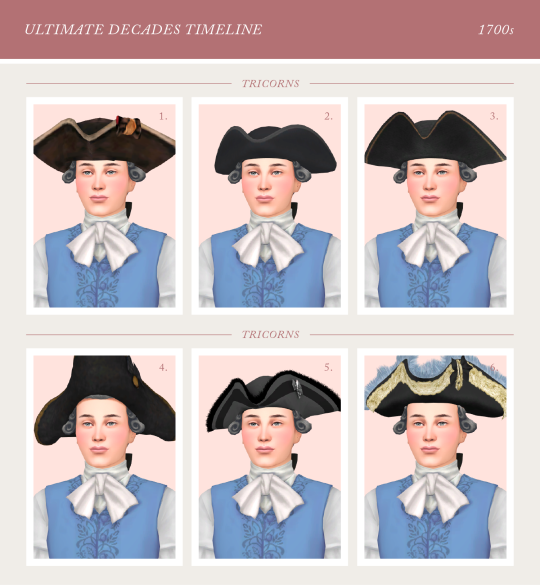
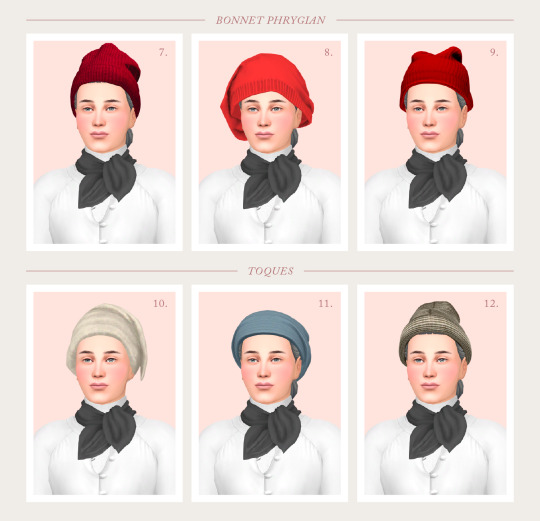
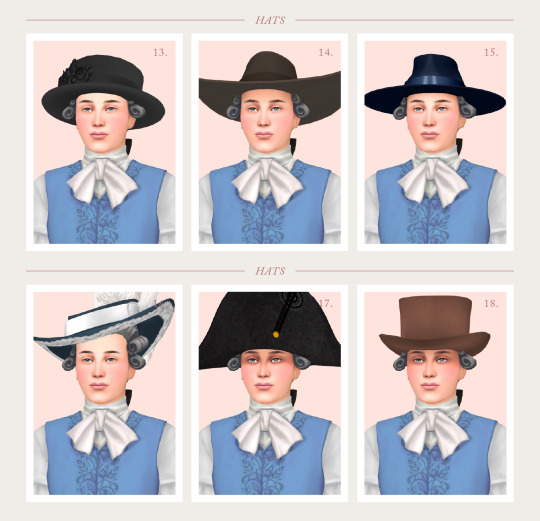
As in the century preceding it, headwear for men was a major component of 18th century fashion. The tricorn, or cocked hat, was hugely popular among both military and civilian men. Caps were another common style, with working class men wearing the knitted variety and upper class men wearing a 'night cap' as a form of undress when not donning their wigs. The bonnet phrygian or bonnet rouge was a sartorial signifier worn by hardcore revolutionaries in the latter part of the 1700s, with the red colour representing liberty and equality. CC links and reference images under the cut.
You can find more of my historical content here:
1300s ✺ 1400s ✺ 1500s ✺ 1600s ✺ 1700s ✺ 1800s

1 - British Uniform Tricorn by Revolution Sims
2 - Tricorne Hat by BokchoiJo
3 - Pirate Hat by Plaza Sims
4 - Washington's Hat by Revolution Sims
5 - Cavalier Hat by Strange Storyteller Sims
6 - Tricorn Hat by Acanthus Sims (retired - direct download)
7 - Beanie 01 by OranosTR (TSR)
8 - Oversize Knit Beaniet by Charonlee SIMS
9 - Fall Beanie by Joan Campbell Beauty (TSR)
10 - Night Cap by Simverses
11 - Floppy Beanie by BokchoiJo (TSR)
12 - Beth Beanie Hat by Blahberry Pancake
13 - Elizabeth Hat by Melonsloth
14 - Western Hat by LuxySims (Curseforge)
15 - Modern Mafia by LEXEL (TSR)
16 - Cocked Hat by Acanthus Sims (retired - direct download)
17 - Elegant Bircorne by Cringeborg
18 - Arcane Hat by Pralinesims (TSR)
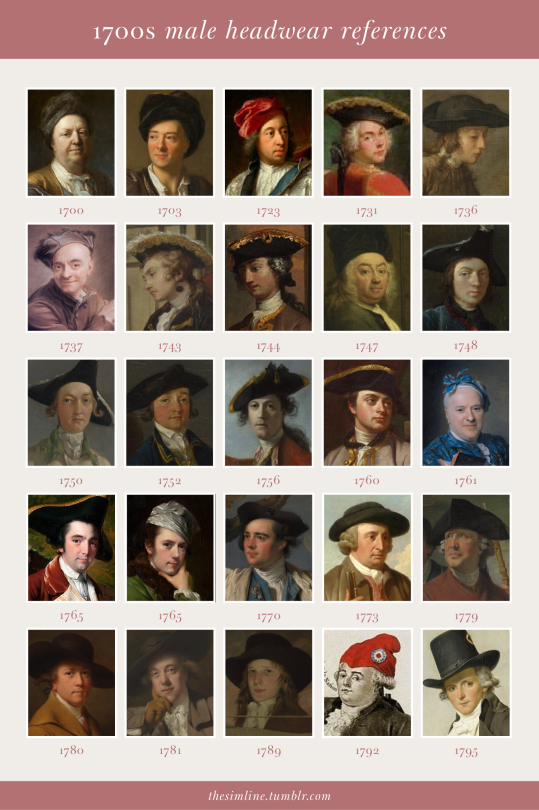
With thanks to some amazing creators: @bokchoijo @plazasims @strangestorytellersims @simverses @melonsloth @cringeborg @lexel-sims-cc @pralinesims
#1700s#1700s cc#georgian era#georgian#rococo#rococo fashion#georgian fashion#ultimate decades challenge#ts4 decades challenge#historical cc#18th century#ts4 history challenge#sims 4 history challenge#sims 4 historical#sims 4 decades challenge#cc finds#sims 4 cc#the sims 4 cc#ts4 custom content#ts4 historical
209 notes
·
View notes
Text
Just going to leave a few descriptions here for all the Luke/Nicola/Polin haters out there who think the BAFTA TV awards are not a big deal.
The BAFTA TV Awards, or British Academy Television Awards are the equivalent of the Primetime Emmy Awards in the United States.
The BAFTA Awards recognize the best in film and television in the United Kingdom, and along with the Oscars, are the two most important awards in the world of entertainment.
The BAFTA TV Awards are considered a "big deal" within the television industry, especially in the UK, as they are seen as one of the most prestigious awards for television, often viewed as the British equivalent of the Emmy Awards, signifying high quality and recognition for outstanding performances and productions.
We all know if this were your faves up for a BAFTA TV awardl (even one voted on by the public), you'd be smiling from ear to ear with pride and shouting it from the social media rooftops.
For me personally, if any of the actors from any season of Bridgerton were up for a BAFTA TV award, I would be thrilled for them and sharing the s**t out of that news. But some unfortunately cannot see beyond their hatred for two of the show’s main characters and the actors that play them.
So you do you haters, and we who support the show as a whole will be over here being damn proud of the accomplishments of all involved, and in particular this awards season for Luke, Nicola and Polin.
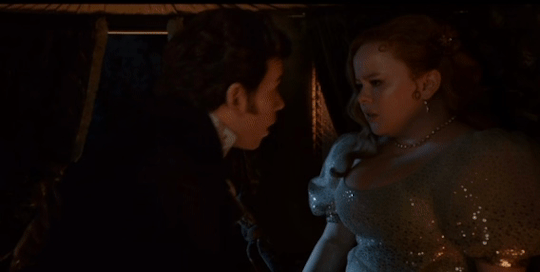


#Polin#Bridgerton season 3#carriage scene#polin season#bafta tv awards#most memorable moment#luke newton#nicola coughlan
97 notes
·
View notes
Note
I'm sorry but basically every criticism of Trump now is attacked with asking the critic "What is a woman?" (Even anti-trans democrats get attacked with a 'but you support people who don't know")
So trans people are going to have to figure out a protrans answer besides the circular "a woman is someone who identifies as a woman" at some point.
(Of course TERFs actually have revealed one piece of hypocrisy recently after the recent British ruling. (Passing trans men are now not allowed to use either public toilets and they support that))
Although trans people absolutely suck at being strategic so that's probably not going to help...
passing trans men are not allowed to use either public toilet? that fucking sucks. gonna take a wild fucking stab in the dark and say this is due to obvious misandry and regarding men as inherently threatening, and then also not thinking about or addressing trans men at all. Like, "people who look like men cannot go into the women's restroom (because men are inherently threatening and women are inherently imperiled), and also trans people have to go to the bathroom for their AGAB," would be my guess.
"What is a woman" is right now a fucking Magnum-caliber shot at the progressive position because their stances require nobody to be able to answer that question and also require the answer to that question to be specific and extremely important so that women can be protected and revered and men can be despised and blamed. It's just like "It's okay to be white," a statement they cannot possibly answer without either being kicked out of the progressive coalition or being obviously foaming at the mouth insane. It's putting pressure on a weld joint of the progressive coalition, the Gender Fandom and feminism. The fact that there's a huge overlap between these two groups and the fact that most people who hold one of those positions also hold the other despite being mutually contradictory sure as fuck doesn't help because you can't even separate the groups.
Progressives don't believe, by the revealed preferences of their behavior, that anyone who wants to be a woman is one and gender isn't real. They strenuously police gender, just by a different set of guidelines than traditionally so. "Women and femmes." All genders welcome, across the entire gender spectrum, except men. Men are still bad, and are toxic masculinity, except for the bearded Wokemen who are already my friends and apologize for being men (and also always get revealed to be sexually abusing a bunch of people that I covered up for after five to ten years).
Trans people suck at being strategic but that's not their fault and not particular to them, because no uncoordinated movement and/or demographic is capable of strategic planning. They can't communicate and coordinate to do that. The progressive movement has leadership, mostly informal and mostly the revealed-preferences kind, and it sucks at being strategic because it has to choose "give status and resources and attention to psychopaths" over "be effective in accomplishing the goal" every time. You can't coordinate the demographic of "trans people" to fix the progressive movement, only try and spread new standards and ideas that eventually trickle up to how the leadership has to interact with them. And you can't do that. For reasons already specified, you can't ever afford to divert any of your focus from "signal" to "signified." The Queer Housing Group People are the most detrimental part of the LGBT movement not just because of optics, but because they take positions of leadership by being aggressive and 100% signal / 0% signified, they capture all attention and effort onto themselves, and they twist every idea in the movement around themselves until they're utterly broken and nonfunctional. Trans people can't kick them out for reasons both sympathetic (I can't afford to turn away any potential ally, I don't want to become like the people who persecuted me for improperly performing gender, I worry I am not passing and may even be correct to worry and how could I say to kick out people who don't pass when that's both cruel and dangerous to me) and unsympathetic (I am obligated by basic human psychology to give everything I possibly can to support an abusive psychopath in my midst).
The pro-trans answer I can come up with, and the one I've used to convince transphobes or trans-skeptics on the occasions I do so, is this: "There's a bunch of things that define a woman when you interact with someone normally, you don't do PCR tests on people before you talk to them to know what pronouns to use and that's not really relevant to your life. There's more mannish women than trans women, and if someone acts like a woman, looks like a woman, sounds like a woman, etc, then even if some of those things are on the 'mannish' end of woman-ness, they're probably a woman. Why does it matter what their DNA is, how does that help?" plus other medical stuff about neurology and proprioception etc. But "Eh, a woman is a wibbly-wobbly, timey-wimey stuff, you kinda gotta squint at it" is not a really compelling slogan when you don't get to have an extended conversation with someone about it. And it's gonna be a mega, mega hard sell to people who are extremely and accurately worried about their ability to pass, and rightly so. It would be great if we could make this the new rule and also change the rule so "passing" includes "clearly trying their best" except you also can't do that, you can't change people's views of that unless you've already won everywhere else and the people who are genuinely trying to pass won't feel any safer and the people making no effort to pass will demand people see them as passing.
Like most Culture War problems, there is no solution because everyone will not just. I try my best to convince individual people, but that's not a solution at scale, the things I say are obviously going to be seen as transphobic by a bunch of trans people even the ones who are sincere, and also "you should accept this idea and step one of doing that is to completely ignore every person you can see who advocates for it" is a hard fucking sell.
77 notes
·
View notes